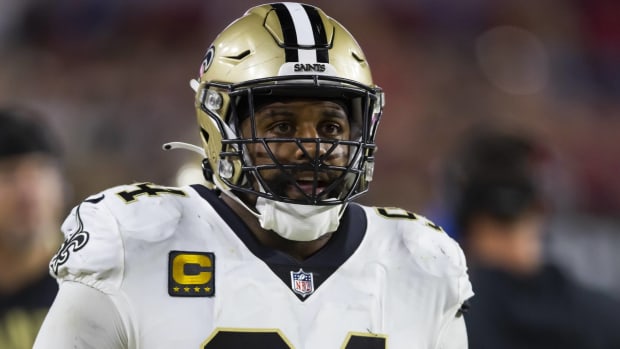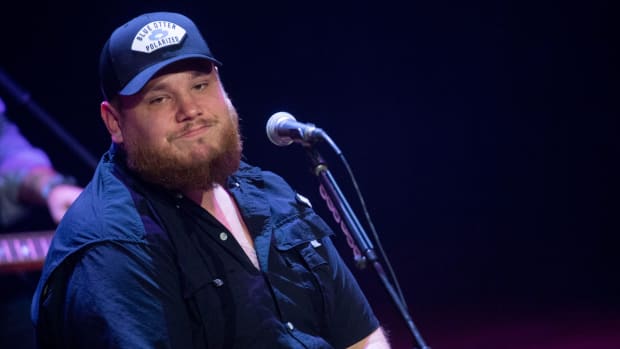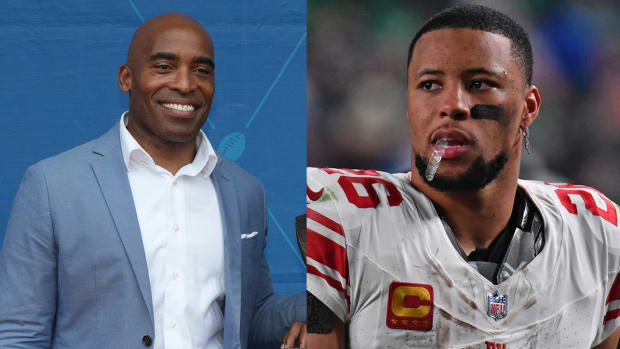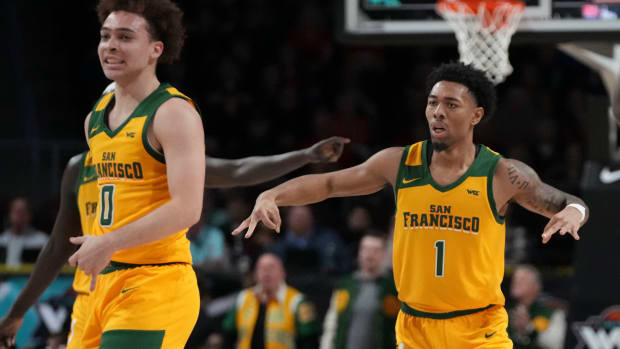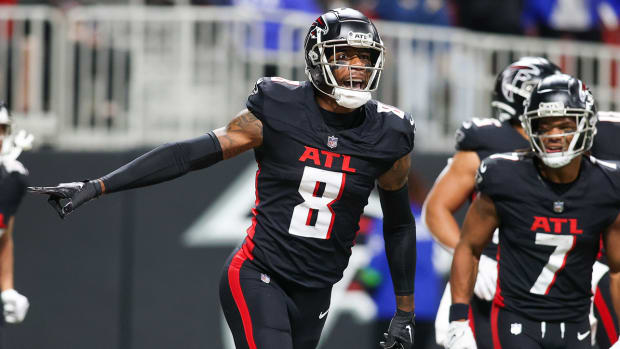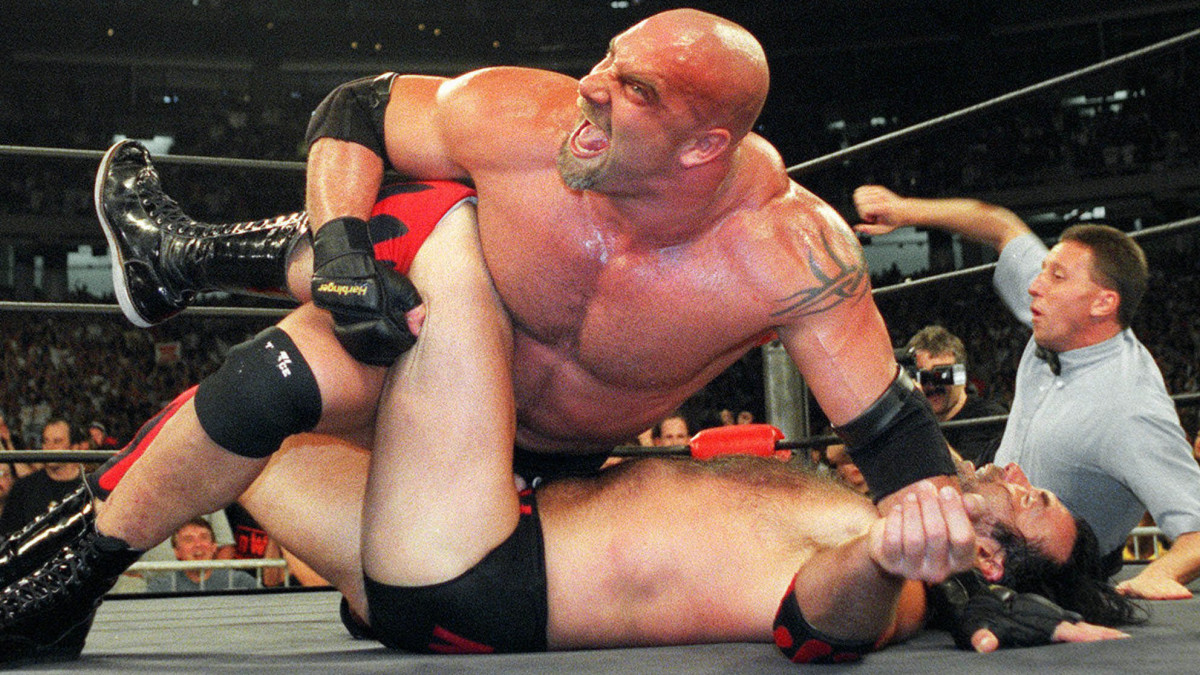
Week in Wrestling: Interviewing New Japan’s head booker; Goldberg’s WCW origins
SI.com’s Week in Wrestling is published every Wednesday and provides beneath the surface coverage of the business of pro wrestling.
In this week’s issue we have an interview with head New Japan Pro Wrestling booker Gedo, The Shoot with Colt Cabana, the Nitro Files with Eric Bischoff, the Top Ten with Mr. Athletic Jeff Cobb, and Five Questions with James Ellsworth.
Booking New Japan with Gedo
SI.com spoke with Gedo, the head booker of New Japan Pro Wrestling, and discussed the New Japan booking philosophy, learning from Paul Heyman, and working with Chris Jericho in WCW. Gedo also discussed the fundamental differences between WWE and New Japan.
When asked to compare WWE to New Japan Pro Wrestling, Gedo explained that there is no comparison.
“We are not a soap opera,” said Gedo. “We are not sports entertainment, we are not acting and not dancing. We wrestle and we are wrestling – we are New Japan Pro Wrestling. Watch a Shibata match and the way he kicks, that’s New Japan Pro Wrestling. [Tetsuya] Naito, [Hiroshi] Tanahashi, and [Tomohiro] Ishii all wrestle and fight. That is entertaining, but it is not entertainment. It’s wrestling.”
Gedo is 47-year-old Keiji Takayama, but is far better known as Gedo from his illustrious career in wrestling in Japan, WCW, and now as head booker of New Japan Pro Wrestling. He also serves as the manager for New Japan’s world champion Kazuchika Okada, who holds the IWGP championship.
“Okada has everything, and he is the best wrestler in the history of wrestling,” said Gedo. “Not New Japan history, I’m talking the world. He’s better than Antonio Inoki, better than Giant Baba, and better than Choshu Riki. He already has ten years of wrestling because he started at 15 years old, and he’s still so young. He’s like The Rock. He has good looks, can talk, and can fight.”
[youtube:https://www.youtube.com/watch?v=Q0Arq6AymZ4]
Although Gedo has a Hall of Fame wrestling portfolio, one piece missing from his resume is a run in WWE. He was offered a WWE contract in 2007, but declined the offer because it required him to portray a stereotypical Japanese character.
“WWE has characters, and it’s not that big a deal,” noted Gedo. “You need characters that people can understand and like, but that’s not as important as skill. Characters are different in the United States than they are in Japan. Skill and fighting spirit are most important, much more than character, in Japan. Ultimately, my most important thing is my partner, Jedo. I choose to stay with my partner.”
WWE remains the most powerful wrestling promotion in the world, but New Japan and WWE both have extended reach. Just like WWE created its own Network, New Japan has New Japan World, which is a phenomenal network that allows viewers to keep in touch with the product and occasionally includes English commentary from Ring of Honor’s Kevin Kelly and Steve Corino.
America and Japan are continents apart, but Gedo explained that their wrestling psychology is still the same.
“Wrestling is wrestling,” said Gedo. “There isn’t a different psychology in Japan than there is in the United States.”
Gedo is well-versed in American wrestling. His own wrestling convictions were influenced heavily by the Southern style brawling of greats like Terry Funk and Jerry “The King” Lawler.
“I grew up loving Southern wrestling in the 1970s,” said Gedo. “That was great. I enjoyed Terry Funk and Jerry Lawler – they were physical, authentic, and had that fighting spirit. Wrestlers now are even more physical and much better, but they don’t know how to capture that spirit. Terry Funk had the spirit.
“My heroes growing up were Terry Funk, ‘Beautiful’ Bobby Eaton—he was an awesome wrestler, and I love the way he bumped, they were beautiful bumps—Ric Flair, and Harley Race.”
The difference between New Japan and WWE, Gedo noted, is a different emphasis toward physicality.
“Most important thing in Japan is spirit—the fighting spirit,” said Gedo. “We have wrestling, not dancing. New Japan is fighting. New Japan boys have fighting spirit, and that leads to great wrestling. They can’t handle the New Japan style. New Japan wrestlers could wrestle in WWE, but they can’t handle our style.”
Gedo has a talented mind for the business and enjoyed a fulfilling career in wrestling, and credits his success to a willingness to learn from those around him – like Paul Heyman.
“I respect Paul Heyman,” said Gedo. “He has many, many good ideas—ideas that make money. Other wrestlers didn’t understand that his ideas would make them money, but I understood that.
Former WCW broadcaster Mike Tenay called Gedo “the Japanese Dusty Rhodes” in 1997 because of his psychology and the way he worked. Gedo noted that his experience in WCW forever impacted his belief that wrestlers should be based off skill and not size.
“I got to work with Ultimo Dragon and Chris Jericho in WCW,” said Gedo. “Chris Jericho told me that Chris Benoit pushed for a big push for me. It was a good experience for me. There were a lot of big guys there, but they couldn’t wrestle like Benoit, Eddie, Dean Malenko, and Rey Mysterio. They showed that we should highlight skill over size in the main event. That was a good learning experience for me.”
Gedo’s preference toward skill is particularly important as New Japan pushes Kenny Omega—a former light heavyweight in New Japan’s UFC-esque weight class system—into the main event of Wrestle Kingdom (New Japan’s version of WrestleMania) this Janaury.
“Kenny Omega has everything,” said Gedo. “I think he’s better than AJ Styles. He’s so good and one of the best in the world—and he’s unbelievably physical. Kenny Omega is no longer a junior heavyweight, he’s one of the best.
“Sometimes wrestlers break weight class, but that is a good thing to happen. Look at boxing and UFC—weight classes are very strict. Sometimes junior heavyweight guys break into the heavyweights in wrestling, and that is special.”
Chris Jericho is a former cruiserweight champion who evolved into a multiple-time world heavyweight champion, and Gedo is extremely impressed with his friend’s continued success.
“Chris Jericho has a great mind,” said Gedo. “I’ve known him for a long time, and he is different than a lot of other guys. He is always looking for something, trying something new. He’s always thinking and has that mental edge. He is very smart.”
As for Shinsuke Nakamura leaving New Japan for NXT, Gedo wished the former IWGP champion his best.
“I am happy he’s doing well,” said Gedo. “He is my friend, and I hope he’s successful.”
Gedo expressed his gratitude for the phenomenal support from fans in the United States
“We are thankful that the American people are so interested in New Japan,” said Gedo. “We want to deliver great matches and show we’re better than anybody, that New Japan is the best company.”
News of the Week
WCW may be dead, but the “Monday Night Wars” are still alive and well for Vince McMahon.
Bill Goldberg’s return to Raw this past Monday felt eerily similar to WWE’s buildup to Sting before his match with Triple H at WrestleMania 31. Much to the surprise of everyone watching, Triple H defeated Sting in his ‘Mania debut, protecting the WWE banner, which is the same fate Goldberg will endure at the hands of Brock Lesnar.
Unlike Goldberg, Lesnar is a homegrown WWE talent, and I expect him to avenge his WrestleMania 20 loss to Goldberg at Survivor Series. Both talents were set to leave the company after WrestleMania 20 and the match—in stark contrast to the New Japan farewell classic between AJ Styles and Shinsuke Nakamura this past January at Wrestle Kingdom 10—was an unmitigated disaster. WWE has some serious advantages this time around, as Goldberg will remain involved with the company on a Legends contract and I have been informed he will also be part of the Hall of Fame class for 2017, but the ace in the hole for current success is Paul Heyman, whose brilliant promos have already built this match to a legitimate main event level.
As exciting as the match – and especially the build-up – looks, make no mistake about who’s doing the j-o-b: Goldberg, one of the biggest stars WCW ever created, is not defeating Brock Lesnar at the Survivor Series.
In other news…
• Goldberg’s promo on Raw was fantastic, but Michael Cole referring to Goldberg as the “greatest champion in WCW history” is pure hyperbole, as well as an insult to Ric Flair, Sting, and yes, “Hollywood” Hulk Hogan. Why not instead call Goldberg the most spectacular or most dominant?
• Fact or fiction with Eric Bischoff: is Goldberg the greatest WCW champion of all time? “How do you put value on it?” asked Bischoff. “I think it is hard to put value on it, but if you were an accountant and you were to approach that question from an accountant’s point of view, you would say that’s absolutely not true. If you’re a hardcore wrestling fan who watched WCW evolve from the NWA days, you would say that’s absolutely not true. But if you were a product of the ‘Attitude Era’ and that’s when wrestling had its biggest impression upon you, then I understand why you’d feel that way. It all depends on your perspective.”
• In the “Fact is Sometimes Stranger than Fiction” category: When Brock Lesnar made his mixed martial arts debut against Min-Soo Kim at Dynamite!! USA on June 2, 2007, the announcing team consisted of play-by-play commentator Mauro Ranallo and... color commentator Bill Goldberg.
[youtube:https://www.youtube.com/watch?v=3euHn9YCwjg]
•The North American television debut of New Japan’s Wrestle Kingdom 10 main event, featuring Hiroshi Tanahashi versus Kazuchika Okada, will be broadcast on this Friday on AXS TV at 9pm ET.
• Courtesy of Chris Jericho’s Facebook page, the “List of Jericho” has been revealed.
• Don’t expect closure any time soon to the Triple H-Kevin Owens storyline arch. For those in need of a refresher, Triple H pedigreed Roman Reigns and Seth Rollins to ensure that Kevin Owens became Universal champion back in August, and the pay-off is currently scheduled for WrestleMania 33 in a match between Rollins and Triple H.
• I was going to comment on the disarray of TNA Impact Wrestling—company president Billy Corgan is suing the company, and wrestlers were left without entrance music on last week’s Impact—but instead I’ll share the story of 11-year-old Jesse Fullerton, who had his collection of wrestling figures stolen last month. Fullerton has Down syndrome, and could not comprehend why his figures were missing, but thankfully, this story met with a pleasant ending.
• The late Dusty Rhodes delivered his famous “Hard Times” promo thirty-one years ago this October. Rhodes will be honored in next week’s edition of the Week in Wrestling.
[youtube:https://www.youtube.com/watch?v=9py4aMK3aIU]
• The legendary Gorilla Monsoon passed away – at the age of only 62 – seventeen years ago this October. Monsoon received a tribute on WCW’s Nitro by an emotional Bobby Heenan, as well as a video tribute on Raw from Vince McMahon.
• Coming soon: WWE champion AJ Styles connects with Sports Illustrated tomorrow (Thursday) for a story on SI.com, as well as an interview with WWE Intercontinental champion Dolph Ziggler this upcoming Monday.
The Nitro Files: Booking Goldberg
The Nitro Files with Eric Bischoff will delve into a moment from WCW’s Monday Nitro each week. Bischoff, WCW’s president during the company’s most successful years, hosts his weekly “Bischoff on Wrestling” podcast, as well as delivers a “Controversial Video of the Week” with 120 Sports’ Nick Hausman, and plans on proving every week in the Nitro Files that the “truth is out there.”
WCW was knocked constantly in the mid-1990’s for a failure to create new talent. The narrative created by Vince McMahon was that Eric Bischoff could—with the support of WCW owner Ted Turner’s checkbook—simply gobble up any wrestler he wanted. Whether the claim was fictional or not, it was proven incorrect with the emergence of Bill Goldberg in 1997.
Goldberg was, and still is, a bona-fide star created in WCW, and his popularity even surpassed Sting on the babyface side of the card.
“Sting originally set up my introduction with Goldberg,” noted Bischoff. “If you remember—in 1997, WCW was on fire. We went from a distant second, and I’m talking a million miles away from the WWE, to going head-to-head and even beating them in 1997. Bill’s personality, his character, his drive and desire, were a perfect confluence.”
Goldberg’s winning streak, which built to the fictional number of 173-0, began in his debut against Hugh Morris on the September 22, 1997 episode of Nitro.
“The whole ‘Streak’ idea originated because we wanted to bring out the best that Bill could offer without putting him in situations where he was destined to fail,” explained Bischoff. “We needed to keep his matches short and very simple, just because of his lack of experience. He’d only been in the [WCW training center] Power Plant for a few months before we brought him onto television, and that is not enough time to expect an athlete—no matter how talented—to build the skillset needed to have a 12-, 15-, or 20-minute match. If we were going to attain the maximum benefit of what Bill could bring to the table, we had to protect him. There was no other option.”
Goldberg told SI last June, “When I went to WCW, I told Eric Bischoff that I wasn’t going to be some dips--- who was thrown around the ring for $500 bucks a week. I told him, ‘I’m going to make a difference, I’m going to make an impact.’ And with a lot of people’s help—whether it’s the Steiners, or Kevin Nash, who at times was very helpful, Curt Hennig or Rick Rude—the rest is history.”
Goldberg’s irrational confidence, which irritated some of his fellow wrestlers in WCW, was necessary to succeed in the cutthroat, insanely competitive, and political world of pro wrestling.
“Bill has the same intensity today. We saw that again and again in his 2K17 interviews leading up to his appearance on Raw this past Monday night. He’s confident, he’s intense, and he’s not going to take any crap from anybody,” said Bischoff. “He’s got a very clear-cut idea of who he is and what he wants to do, and that intensity, that charisma, and energy is raw and it’s real—and that is no different today than it was in 1997. That’s why the crowd reacted the way they did to him this past Monday night, and that is the core of why people love sports entertainment. They want to live vicariously through a character, and Bill’s character is so true to himself. He’s playing himself with the volume turned up just a little bit, and that strikes a chord with a lot of people.”
A major moment in the history of WCW occurred on Monday, July 6, 1998 as “Hollywood” Hulk Hogan defended the WCW championship against Goldberg on Nitro. Bischoff has dealt with criticism over the years that the match should have main-evented Starrcade that December, instead of used on Nitro to defeat Raw in the ratings.
“Pull yourself back and look at what made Nitro such a powerhouse. It was really because we were the first ones to have the courage and the commitment to put pay per view-caliber matches on prime time television,” said Bischoff. “A lot of fans thought we should have held that match off and it would have had a more positive outcome on the future of WCW, but none of that is true.
“WCW ended up where it ended up because of the decisions that were made by AOL-Time Warner and Turner Broadcasting, and those decisions were made far before we decided to have the match between Hulk and Goldberg. So would it have saved the fate of WCW? No, that’s fantasy. We put pressure on ourselves during the process to have to create a really good story, and sometimes we were successful and sometimes we weren’t, but the formula of putting pay per view quality matches on prime time television was the formula that made Nitro a success.”
The match between Hogan and Goldberg, and the idea to drop the title, was first suggested to Hogan.
“Hulk recognized the power and magnitude that it would have,” said Bischoff. “By doing so, he wanted to elevate Goldberg and WCW. If I had to do it again, I’d probably make the same decision.”
Exclusive Lucha Underground clip
[video:13472050]
Lucha Underground, which is available on iTunes, continues its third season tonight on El Rey Network at 8pm ET.
The Shoot: Colt Cabana
Colt Cabana hosts The Art of Wrestling podcast, as well as a pro wrestling storytelling podcast called Pro Wrestling Fringe. Cabana signed with WWE in 2007, but is best known for his distinguished body of work on the independents. Cabana returned this past spring to Ring of Honor, and blazed a trail by entering the podcasting field in 2010.
My Love Letter to the Independents
Signing with the WWE in 2007 allowed me to prolong my independent wrestling career.
Don’t get me wrong, I had hoped my pitches of sneaking onto Raw as Charlie Haas’ partner or becoming the general manager of WWE.com’s Heat would have meant the start to a nice long career, but in my heart I knew what I was. I was, and I am, an independent wrestler.
I’ve been on the independents since the 90’s. I remember when the indie scene was “hot” on the back of shows headlined by “Superfly” Jimmy Snuka, “Cowboy” Bob Orton Jr., and Greg “The Hammer” Valentine.
In 2006, I felt stale on the independent scene. By then, I had done programs in Ring of Honor with Homicide, Nigel McGuiness, Jimmy Jacobs, as well as enjoyed a successful tag team run with CM Punk. The independents were an extension of the long-gone territories and I could only stay for so long. Three years previously I had done the same thing by spending an extended summer touring Great Britain. I had left, I had gone away, and I’d hoped to come back with a fresh coat of paint.
That’s how I viewed my signing with WWE. I felt, as long as I could “make it” a year in developmental without getting fired, I’d consider it a success. I would be able to come back to Ring of Honor and the independents as a rejuvenated commodity. WWE was a completely different place ten years ago. Being an “independent superstar” was NOT a cool thing. My path to success was considered the wrong one. I was an outlaw. Two years later I found myself back in the position I always kind of assumed I’d be in: the independents.
Ring of Honor was built on the backbone of wrestlers who were amazing wrestlers, but just didn’t have “the look” that the WWE was looking for: 6’5,” 240 pounds. We were none of that. We were all young hungry wrestlers who just wanted to wrestle. There were no territories left so we wrestled anywhere and everywhere we could. This, to me, is the true spirit of the indies.
I have wrestled at a fat camp. I’ve wrestled on the border towns of Mexico. I’ve wrestled for the Insane Clown Posse. I’ve wrestled for porn stars. I’ve wrestled for a company called “Bloody Midgets”. I’ve wrestled for the Inuits in the northern most part of Canada. I’ve wrestled with Aborigines in Australia. I’ve wrestled in front of the Yakuza in Japan. I’ve wrestled for hipsters drinking cheap beer and wearing ironic lucha masks.
These are just a handful of experiences in the crazy world of independent wrestling. Of course, four hundred amazing fans in Reseda, Calif., at Pro Wrestling Guerrilla watching William Regal scout The Young Bucks and Adam Cole gives the independents a romantic look, but that is only a fraction of the pie. PWG works as a champion of the scene because of ALL the other ridiculous shows that are also running that same day. The 45-year-old dad retaining his belt in the local VFW hall. The teenage kid who sold 30 tickets and now gets to win the battle royal. The two young girls who have practiced the same routine for over a month and now have completely blanked in the middle of their match.
The independents are filled with everything. The idea of the indies has been around for so long, but unless you were living it, the culture has always been kind of an anomaly.
Bryan Danielson (Daniel Bryan) and I were two guys who, for years, had been doing these odd shows. It was our living. We didn’t just do the local show for fun. We did everyone else’s local show because we wanted to pay our bills. Documenting this lifestyle had been something we’d talked about for years. Originally we had plans on renting a camper for three months and just driving around America, wrestling and filming.
In 2009, we chose ten days of our life and asked our friend Sal Rinuaro to join us and hit the road documenting the life of a real independent wrestler. The Wrestling Road Diaries came out in 2011 and opened a lot of eyes to what this lifestyle really involves. Independent wrestling doesn’t have a TV show. It’s not glamorous, but it is an alternative. It’s a completely different animal and, in reality, although it is pro wrestling, it is selling something completely different that WWE.
I’ve been obsessed with comedy podcasts dating back to 2009. So much so, that I took the idea and started the first long-form, long running wrestler to wrestler podcast in 2010. It was the same idea that Bryan and I had so many years ago. To document the plight of the wrestler through the hardest times of their journey. This time I was doing it in audio form. Again, independent wrestling doesn’t have a TV show.
When I started wrestling in 1999, you hadn’t “made it” unless you were a TV wrestler. The internet has been such an amazing avenue to help even the playing field. As the cable cutters start to grow, the idea of the TV star is no longer the end all be all. As the success of my podcast, The Art of Wrestling, started to grow, I realized that I didn’t need to be a TV star to be successful in wrestling. I knew I made it when I became an internet star.
I will always champion the independents. I cherish wrestling for the great ones, like ICW in Scotland, AAW in Chicago, AIW in Cleveland, Wrestle Pro in New Jersey, Rev Pro in London, and so on and so forth. Even more though, I love saying I wrestled a robot on Friday, a clown on Saturday, and on Sunday someone flew me to Puerto Rico to wrestle in front of fifty people on a basketball court with a wrestling ring and no chairs.
The independents will always be what they are. I am grateful that we are in the infancy of people outside the inner circle really starting to understand the scene. The internet has allowed new avenues and windows to open up to this world.
WWE has built a separate company trying to emulate the magic that the independents have captured. Word is spreading, but the reality is… independent wrestling doesn’t have a TV show… and that’s why it’ll always be our little secret.
Colt’s documentary series, The Wrestling Road Diaries, now includes the brand new Wrestling Road Diaries 3 – starring Colt, Kikutaro, and Grado – and is available for pre-sale at COLTMERCH.com.
Top 10 with “Mr. Athletic” Jeff Cobb
Jeff Cobb and the suplex share a very organic relationship. Cobb—who shares a striking resemblance in size and stature to Lucha Underground’s Matanza Cueto—has wrestled all over the world proving that he is the modern day human suplex machine.
“All the guys I used to love watching—like Taz and Kurt Angle—used to really throw people around,” said the 34-year-old Cobb. “When I started doing amateur wrestling, that was an area where I was really good. I wasn’t very tall, but I was short, stocky, and explosive – and the suplex quickly became my favorite thing to do.”
[youtube:https://www.youtube.com/watch?v=NaT6mvjiklQ]
The 5’10”, 263-pound Cobb, who competed in the 2004 Olympics in freestyle wrestling and wrestles under the nickname “Mr. Athletic,” also wrestles with Pro Wrestling Guerrilla. As a devoted disciple of Taz and Angle and a legitimate suplex machine, Cobb shared his top ten suplexes in wrestling:
10.) The Snap Suplex
The Dynamite Kid and his snap suplex were really special. He was the first person I’d ever seen do it, and he made it look so vicious. I remember Chris Benoit used it for a bit, and he and Dynamite looked like pitbulls throwing you for a quick slam.
9.) The Vertical Suplex
Davey Boy Smith could hold guys up for a long time, but I like to do this suplex on the second rope.
8.) The Tiger Suplex
No one did the Tiger Suplex like Mitsuharu Misawa. It’s just a scary looking suplex, and he gave a really sick version of it.
7.) The Belly-to-Belly Suplex
Kurt Angle does a really, really nice belly-to-belly suplex, and Brock Lesnar does a nice one, too – he’s so strong that he just tosses those suckers across the ring.
6.) The German Suplex
The German is a little over-done, but I don’t throw out fifty of them in a match. If I use it, there is a reason and a purpose behind it to make it special. Brock Lesnar is up there for his power suplex, but I’ve only seen him do a belly-to-belly and a German. Don’t get me wrong, he’s incredible, but I’ve only seen two suplexes from him. Dalton Castle from Ring of Honor has a really nice German suplex, and so does Tazawa – during that Cruiserweight Classic, he showed that his snap German is really sweet.
5.) The Saito Suplex
This was Masa Saito’s suplex, and it’s a devastating move—can be hit completely out of nowhere.
4.) The Perfect Plex
Mr. Perfect was really influential on me, and his fisherman’s suplex, which he called the Perfect Plex, was super cool. He made it look so good that I didn’t think that anybody could get out of that thing. It’s a tough move, and forces you to jump off one leg, but that shows how talented Curt Hennig was. He was so good that you don’t even call it the fisherman’s suplex any more, you call it the Perfect Plex.
3.) The Cobb-Boom
This is my creation. I turn my opponent sideways then back over for a German. That’s my most devastating suplex, and I created it one day when I was challenging myself to see how far I can throw people in weird directions. I love manipulating directions against gravity.
2.) The T-Bone Suplex
Taz had the most vicious suplexes, as well as very inventive ones—the kind you’d never seen before. Taz revolutionized the suplex, and he remains an inspiration to me.
1.) The Regal Plex
It’s kind of in an atomic drop position, and then your right arm goes over your opponent’s head and your left arm goes under his leg, and you clasp your hands and you toss him. William Regal is one of the most solid wrestlers I can think of, and the Regal Suplex looks like it hurts a lot. I use it a little bit and I’ve had it done to me, and it’s a scary ride.
The suplex is deeply ingrained in the landscape of pro wrestling, and is seen so often that people often forget the danger involved in the maneuver.
“If you don’t protect a guy, you’re going to toss him and he’s going to land on his neck, and obviously you don’t want that,” explained Cobb. “I’m very confident in my abilities, so I always protect the guy. If you don’t know what you’re doing, you can hurt someone.”
Foreign territory for Cobb exists when he is on the receiving end of a suplex.
“It feels strange taking a suplex because not many guys throw me around,” said Cobb. “I wrestled [Ring of Honor’s] Raymond Rowe this past Saturday night in Cleveland, and he gave me a suplex—and it felt very awkward to be on that end, but it felt kind of cool to be thrown around.”
Cobb is planning to suplex his way to victory in the PWG’s 2016 “Battle of Los Angeles, especially if his opponent is Ricochet – who knocked him out of this year’s tourney.
“If I’m in the finals of next year’s PWG BOLA against Ricochet, I’ll hit him with the Cobb-Boom, and then I’ll finish him off with my Tour of the Islands slam.”
Five Questions with… James Ellsworth
James Ellsworth battled AJ Styles for the WWE championship last night on Smackdown. Although Ellsworth came up short in his quest to the win the title, he did defeat Styles by disqualification.
Ellsworth, who runs his own promotion, Adrenaline Championship Wrestling, debuted on Raw in a squash match against Braun Strowman on July 25. Thanks to fan support, Ellsworth returned to the WWE, and even defeated Styles in a non-title match last week on Smackdown. Even without the WWE championship, the 31-year-old native of Baltimore has more goals to accomplish in WWE.
SI.com: How did you get your start with WWE? Did you have any expectations for a world title match with AJ Styles?
Ellsworth: There’s a site, it’s called Recruit at WWE.com, and you can send in your resume and pictures. I’ve been doing that for a couple of years, and finally I got the call. I’ve been there for two years as an extra talent, doing small stuff but never wrestling. My first match was against Braun Strowman on Raw. When I shook hands with Vince after the Strowman match and he told me, ‘Good job,’ that was the one moment for me when I felt like the entire experience was surreal. I never, on my life, thought this would happen.
I was hitting Strowman twice in the match, so I said to the writer, ‘Since I’m punching him twice, can I say that, ‘Any man with two hands has a fighting chance’?’ The writer loved it, and he went away and got it cleared, then it took off from there. I never thought in a million years that this was going to happen. I was just there to do my job, and I thought, honestly, you’d never see or hear from me again. The fans on social media were the ones who kept my name out there, and they asked enough times, and then, five or six weeks later, I was back on TV. Then, after that, I got the chance to go into the ring with WWE champion AJ Styles.
SI.com: Is it fair to say that wrestling was your first love?
Ellsworth: I don’t ever remember not wanting to do this. I’ve always wanted to wrestle. This was my childhood dream. I’d watch wrestling on TV, seeing the guys that I looked up to, and thought to myself, ‘That’s going to be me, I’m going to be a wrestler.’ My parents kind of shrugged that off, but I never gave up on my dream. I was also big into baseball—I still watch religiously, and I played until I was fifteen. My parents pushed me more toward baseball, but I always wanted to wrestle and I always wanted to entertain the fans. That’s still my passion.
I started wrestling fourteen years ago in 2002. Two days after I graduated high school, I was signed up and ready to go in wrestling school. I’ve always been so focused on wrestling, and it’s really consumed my life since I was three. This has all been very surreal. I was a fan before the ‘Attitude Era.’ I started at a young age, and my first memories of wrestling are as a four-year-old and seeing the Rock ‘n’ Roll Express and Ric Flair on TBS with the NWA. I was also a fan of Randy Savage and the “Million Dollar Man” and “Ravishing” Rick Rude, so we’re talking 1987 and 1988 as my first memories of wrestling.
I also run my own promotion, Adrenaline Championship Wrestling. I run about twenty shows a year. Our website has gotten a lot more hits since my first match with WWE.
SI.com: In addition to last night, you also wrestled, and defeated, AJ Styles in a non-title match last week on Smackdown. The Styles Clash that he delivered on you looked like you just averted injury. Styles is so fluid and smooth, but was that Styles Clash dangerous?
Ellsworth: It wasn’t smooth, but it wasn’t dangerous. In wrestling, they tell you to, ‘Tuck your chin, tuck your chin, tuck your chin,’ and that’s the one move you don’t do it on. I always use this analogy: if you write right-handed, but then you have to write left-handed, it’s hard to make the transition right away. AJ was safe with it, he was professional, and in my humble opinion, he is the best wrestler in the world. I have nothing but good things to say about him.
SI.com: What stands out most about your experience with WWE?
Ellsworth: I came a half a second away from being the WWE champion! Also, I talk with Chris Jericho a couple times a week through text message. He’s a legend. Mick Foley is another legend who goes out of his way to talk with me, and I can’t thank either of them enough, and I can’t thank the WWE enough for the opportunity. The fans asked for it, and they gave the fans what they wanted – in return, they’ve given me my dream. It’s definitely the best thing that’s ever happened to my professional career.
SI.com: Do you have any future goals you would like to accomplish in WWE? Can you believe you were in the main event on Smackdown?
Ellsworth: A lot of fans have asked if I’ll be in the Royal Rumble, and I like to give the fans what they want. They’ve given me my dream – I would not be here if not for the WWE Universe. It’s all because of them. I’ll never say no to an autograph or a picture. I will never forget what they’ve done for me. If they want me in the Royal Rumble, then hopefully I get a spot in the Royal Rumble.
Tweet of the Week
Every goofy reference to marijuana on Raw—which was in Denver—made me think of Paul Heyman’s classic line that, “Nobody gets higher than Rob Van Dam.”
Justin Barrasso can be reached at JBarrasso@gmail.com. Follow him on Twitter @JustinBarrasso.





